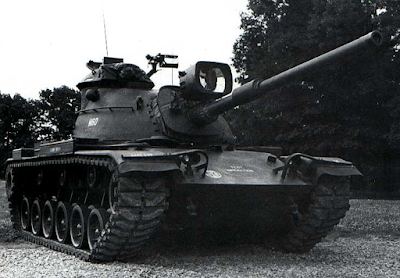By 1954, the T95 universal tank project had been slated for development, which was planned to replace the M48 Patton, and incorporated several new and innovative features. However, the items drawn up for this program required considerable time and resources to develop and so progress on the program was slow. By early 1957, the need for a more immediate design became apparent. While the M48A2 would continue production going forward, the T95 series was cut back to serve as a platform for experimental weapons and systems. In the meantime, new effort was put forward into designing a lightweight airborne tank a new main battle tank. These two vehicles would become the M551 Sheridan and the M60.
Development of the M60 began with the a diesel version of the AV-1790 tank engine, which could consume less fuel and therefore increase the range of the vehicle. While trialed with the M48A2, it was decided the Army was still not progressing fast enough with its tank modernization programs. On 4 June 1959, the XM60 program was formally started, using the X- prefix rather than the T- prefix to emphasize the improvement over past designs. After review, the M48A2 chassis and the AVDS-1790 engine were to serve as the basis for development.
The 105 mm Gun T254 was developed from the 105 mm British X15E8, which itself was a further development of the British 20-pdr. A further development of this gun was T254E2, which had an interchangeable tube with the British weapon and would later go on to be standardized as the M68. A 120 mm and various smoothbore options were also considered, although the T254E2 was most favorable.
Other improvements over the M48A2 included a new T9 cupola for the commander, a simplified fire control system, and even a xenon searchlight. However, despite all this, the XM60 wasn't all that different from the M48A2 on which it was based. While the vehicle would go into production as the M60, it wouldn't be until the turret was replaced entirely with the M60A1 could the vehicle truly call itself an improvement.
As I propose it, the M60 is at Tier IX. It's essentially an elite version of the M48A2, but with a less powerful engine. The front hull is made about 30 mm thicker, however. The gameplay between the two tanks should be fairly similar.
Guns: 105 mm Gun M68
Engines: Continental AVDS-1790-2A (750 hp)
Turrets (Turret Armor (mm)): M60 (178/76/51)
Suspensions/Alternate Hulls, Total Weight (metric tons): M60 (46.27)
Suspensions/Alternate Hulls, Total Weight (metric tons): M60 (46.27)
Hull Armor (mm): 143/74/41
Top Speed: 48 km/h
Sources:
Hunnicutt, R. P. Patton, 2015

No comments:
Post a Comment